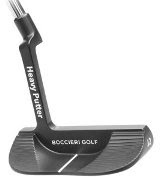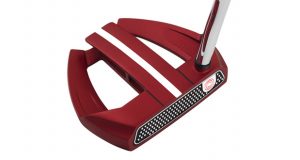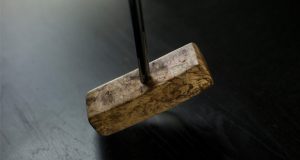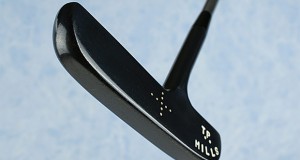The Heavy Putter is back, and it’s sleeker and slimmer than ever. When the first Heavy Putters were introduced by Boccieri Golf more than four years ago, they turned heads with their unconventional looks and opened minds with their unique weighting properties. The secret to the Heavy Putter’s success isn’t just the heavier putter head, but also a counterweight in the shaft that raises the balance point and quiets the wrists.
After really pushing the design envelope with its Heavy Putter Deep Face Series putters last year, Boccieri Golf unveiled a new concept heading into this year—the lighter and more traditional-looking Heavy Putter MID-WEIGHT Series. The Heavy Putter MID-WEIGHT K4 model recently received high marks from PutterZone.com for its classy good looks and compelling weighting system. PutterZone.com recently caught up with Heavy Putter inventor Stephen Boccieri to get the scoop on the new Heavy Putter MID-WEIGHT Series. Following is our exclusive interview:
What was the inspiration behind the new MID-WEIGHT Series?
This is a simple one! For the past few years, consumers have been asking for a lighter Heavy Putter. We were told that the original Heavy Putter was just too quantum a leap in weight for a golfer to adapt to—even though our early research indicated that the heavier weight was clearly a benefit to the golfer’s biomechanics and that it would produce a more consistent stroke. The overwhelming evidence was not enough to convince most golfers. So we decided to embark on another research study that would redefine the Heavy Putter category.
How do they compare and contrast to earlier Heavy Putter models, and how have they been received so far?
The concept is basically the same: increased weight in the head of the putter with a counterweight in the grip end of the shaft. The difference is that we lightened the head to 400 grams from 465 to 475 grams and we reduced the counterweight to 200 grams from 250 grams. This produced a putter with a total weight of 750 gram versus the original weight of 900 grams. The total weight is the key to improved consistency of the stroke, and the higher balance point produced by the counterweight reduces the activity of the hands and wrists.
The testing we did that lead us to our 2009 advertising campaign indicated that seven out of 10 golfers preferred the new MID-WEIGHT to the putter in their own bag. So far, early retail results are indicating a four-times inventory turn, which is way beyond expectations. Most retailers are satisfied with a two-times turn of inventory in the putter category.

This is the most traditional looking line of Heavy Putters to date. Was that a conscious decision?
During our testing, we decided to reach out to golfers across the nation and ask them exactly how and what they look for when buying a putter, and I must admit the answers surprised me. More that 85 percent of those surveyed wanted the see putters that were considered to be the classics and not new shapes that resemble the Starship Enterprise. One of the other interesting findings was that golfers really didn’t like the loud colors that the OEM’s were using on their grips. They simply wanted a black grip. We tried to listen as best we could and decided to give the golfer what we believed would be their dream putter.
There’s naturally a bit of a learning curve when it comes to educating golfers about the Heavy Putter compared to lighter, more traditionally weighted putters. What are some of the misperceptions that you have to overcome?
You’re right about the educating part, but surprisingly most golfers in a one-on-one really understand the benefit of increased weight to improve the consistency of the stroke. They do have a harder time understanding that the higher balance point will quiet their hands. They still feel like the putter needs more head feel, which of course would require lowering the balance point and thus cause the hand and wrists to become more active.
There are two major misconceptions we encounter continually with the use of a Heavy Putter. The first is that the putter can’t be good on fast greens. Well, the truth be known, the Heavy Putter is better on fast green because the putter is traveling at a much slower speed at impact and actually requires a larger stroke to propel the ball the same distance as a lighter conventional putter. This always surprises golfers the first time they putt with a Heavy Putter. They usually come up short of their target. It’s fun to watch their expressions after they see the result.
The second misconception is the putter must not be good for long lag putts. Well, once again the opposite is true. The Heavy Putter produces a more simple pendulum style stroke with less wrist and hand motion during the stroke, and simply requires an increase in stroke length to increase distance versus a conventional putter that requires a substantial amount of “hit” in the stroke to propel the ball the intended distance. The only problem with the “hit” is how much hit do you apply to the stroke to achieve the correct distance. This simply means you must adjust the force you apply to every length of putt instead of just increasing the length of a simple pendulum. If done correctly, the distance control with the Heavy Putter is machine-like.
The last time we chatted, you had a driver on the drawing board. Are you still exploring different clubs? What can we expect next from Boccieri Golf and Heavy Putter?
The launch of the MID-WEIGHT Series of Heavy Putters has taken every bit of my focus. During these uncertain economic times, I wanted to make sure we had a solid foundation in the putter category before we enter another category in the volatile golf market. But rest assured, I dream about golf and improving golf equipment every day of my life. That’s what I do.
Thank you, Stephen!
 PutterZone – Best Putter Reviews
PutterZone – Best Putter Reviews




The heavy putters gives strength and power to the ball, it works to make a good and higher effect to the ball.
The heavy putters gives strength and power to the ball, it works to make a good and higher effect to the ball.